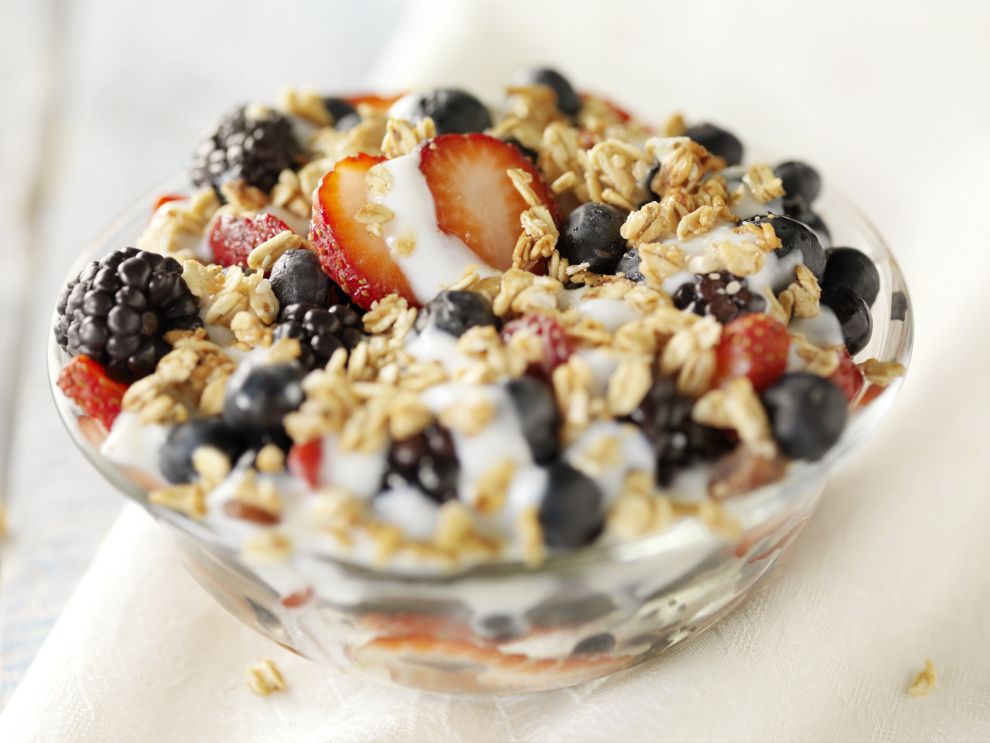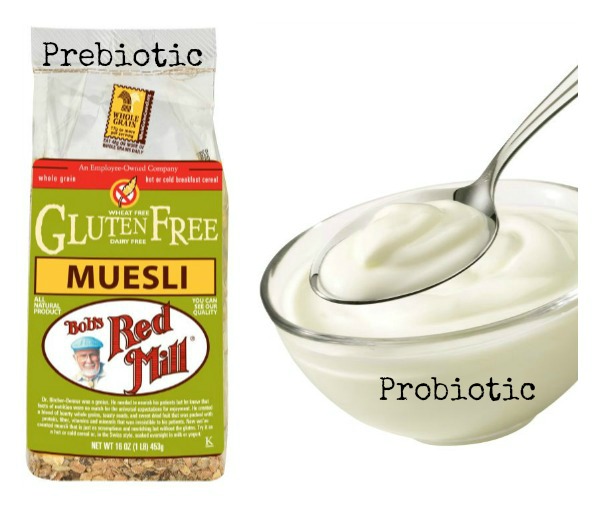Cassidy is the Bob's Red Mill spokesperson...even she refers people to me!
Tara,
You’re delving out of our knowledge zone and we’re not sure what to tell you. Perhaps Tim can enlighten you."
Getting Gastrointestinally Groovy: Prebiotics and Probiotics
It’s hard to miss the probiotic trend in the food industry these days. Probiotics are good bacteria that aid in the balance of our digestive tract. These microorganisms aid in digestion and support our immune system. They can help prevent intestinal upset and aid in the treatment of certain infections. In fact, if you’ve recently taken antibiotics, you’ve likely wiped out your good bacteria. Probiotics will help replenish your bacteria stash and get you back to your old self.
These good bacteria are found in many packaged foods (everything from chocolate to protein bars to ice cream), but are naturally occurring in yogurt, kefir, kombucha, sauerkraut, miso, kimche, and tempeh, to name a few. Notice that each of these foods is a fermented product. Fermentation is the result of active bacteria growth. To cause fermentation, bacteria is introduced to the food. This bacteria converts the foods sugars to acid, gas or alcohol. When ingesting these fermented foods, you add a live organism (more like millions of live organisms) into your digestive system. These organisms work to breakdown foods in your body and out-compete the bad bacteria that make us sick.
Probiotics are awesome, but they can’t work alone. That takes us to prebiotics. Prebiotics are the food that probiotics need in order to survive and get busy in your body. It makes sense, in order to out-compete the bad bacteria and thrive, these good bacteria need some fuel. Just like you combine sugar and water with yeast to activate it in order for your dough to rise, you need some kind of sugar to get these probiotics charging.
Not all sugars are created equal, however, so don’t grab a doughnut and think you’re helping out your kombucha with some fuel. The best prebiotics are whole grains, legumes and fruit, but other foods high in fiber are also good prebiotics. Fiber is key because it is the “waste” from your food that sticks around in your digestive system. This waste product is exactly what the bacteria need to thrive. Any food without fiber won’t offer up much of use to the good fauna in your system.
Here are some great ways to combine prebiotics and probiotics for a healthy, happy digestive system.
These good bacteria are found in many packaged foods (everything from chocolate to protein bars to ice cream), but are naturally occurring in yogurt, kefir, kombucha, sauerkraut, miso, kimche, and tempeh, to name a few. Notice that each of these foods is a fermented product. Fermentation is the result of active bacteria growth. To cause fermentation, bacteria is introduced to the food. This bacteria converts the foods sugars to acid, gas or alcohol. When ingesting these fermented foods, you add a live organism (more like millions of live organisms) into your digestive system. These organisms work to breakdown foods in your body and out-compete the bad bacteria that make us sick.
Probiotics are awesome, but they can’t work alone. That takes us to prebiotics. Prebiotics are the food that probiotics need in order to survive and get busy in your body. It makes sense, in order to out-compete the bad bacteria and thrive, these good bacteria need some fuel. Just like you combine sugar and water with yeast to activate it in order for your dough to rise, you need some kind of sugar to get these probiotics charging.
Not all sugars are created equal, however, so don’t grab a doughnut and think you’re helping out your kombucha with some fuel. The best prebiotics are whole grains, legumes and fruit, but other foods high in fiber are also good prebiotics. Fiber is key because it is the “waste” from your food that sticks around in your digestive system. This waste product is exactly what the bacteria need to thrive. Any food without fiber won’t offer up much of use to the good fauna in your system.
Here are some great ways to combine prebiotics and probiotics for a healthy, happy digestive system.
- Muesli and Yogurt- the ultimate in a healthy breakfast or snack. Pick yogurt that lists either Lactobacillus or Bifidobacterium in the ingredient list as a live culture. Choose a plain or vanilla flavor that is low in sugar for the most nutritious choice. Muesli is unsweetened, but contains dried fruit that will add a nice sweetness to your meal. The whole grains provide the prebiotic fiber and the nuts and seeds will give you an extra omega-3 bonus.
- Brown Rice and Tempeh- combine a whole grain brown rice with tempeh for a one-two prebiotic/probiotic punch. Add vegetables sauteed in olive oil for a heart-healthy complete meal.
- Whole Grain Crackers with Yogurt Dressing/Dip – Replace sour cream in your favorite dressing or dip with a probiotic-packed yogurt and pair with whole grain crackers, bread or even drizzle over a whole grain salad. Try this Creamy Avocado Yogurt Dressing from Mother Thyme and these Savory Hemp Crackers for a wonderful omega-3 rich snack.


I have been reading about the effects of Raw Potato Starch (RPS) when used as a source of Resistant Starch (RS).
When fed adequate amounts of RS, people’s gut bacteria thrive and many metabolic changes occur such as decreased absorption of cholesterol, lower fasting blood glucose, and better glucose control.
I have been taking 4TBS of Bob’s Red Mill Unmodified Potato Starch daily for several weeks, and have noticed an immediate lowering of fasting blood glucose from a high level (120) to a perfectly normal level (90).
In order to get the benefits of RS from RPS, the potato starch has to be ingested cold–not heated above 140 deg F. This allows the RPS to completely avoid digestion in the small intestine and arrive in the large intestine where it serves as food for beneficial gut bacteria.
I was wondering if you know the source of Bob’s Potato Starch and the manufacturing process used to make it?
If you would like to discuss resistant starch further, please contact me via email and I will send you studies and papers and discuss personal experience.
Thanks,
Tim
Our potato starch is made from starch potatoes using an extraction process. Starch potatoes are mechanically peeled and boiled then ground into a pulp. After grinding the potatoes and separating the fruit water from the potato pulp, the starch is extracted out of the potato pulp with tap water. The starch is then separated from the fibres by fine sieving.The extracted starch passes the fine sieve and fibres flow off the sieve. For more information, please contact our customer service team at 800-349-2173. Thanks!
Tim
Presently, the only commercially marketed RS is Hi-Maize corn starch, but it is only used in baking. Potato starch can simply be added to cold food like potato salad, smoothie drinks, and mixed with milk or other beverages. It must be consumed cold.
I’m curious in your description of your processing methods, you say they are peeled and boiled…it seems boiling at this stage would gelatinize the starch making it impossible to separate later…is this accurate?
This is the information we have from our supplier on the manufacturing process. Please contact our customer service team for more info. Thanks!
For your info, Bob’s Red Mill Unmodified Potato Starch is manufactured in a way that makes it an EXCELLENT source of resistant starch. 2-4TBS a day, in a raw form (added to smoothie, potato salad, fruit salad, etc…) is an optimal amount for super gut health.
When you start hearing more about Resistant Starch in the future, remember this comment and pitch it to Bob–you’ll make money! People need a way to get a measured dose of RS easily–potato starch could be the ticket!
There’s not much out there in the way of Resistant Starch. Raw Potato Starch is 78% RS by-weight…that is huge!
See table 2 for other RS contents and info on the benefits of consuming RS.
http://onlinelibrary.wiley.com/doi/10.1111/j.1467-3010.2005.00481.x/full
I’m confused. I just spoke to customer service regarding Bob’s Red Mill Potato Starch and was told the potatoes were boiled/cooked as part of the process of making the potato starch they sell. This goes against the idea that Potato starch should be raw in order to have enough resistant starch as a pre-biotic supplement. Tim however, you say that customer service satisfied you that the BRM potato starch is processed in such a way as to maintain it’s high resistant starch content. Can either of you elaborate on either the process used to make the BRM potato starch or why it is a great source of pre-biotic resistant starch? Thanks for the help:)
Based on Tim’s answer, I think he means that you eat the starch raw- not that the potatoes are raw. So it should be a great source of resistant starch.
“I just spoke to customer service regarding Bob’s Red Mill Potato Starch and was told the potatoes were boiled/cooked as part of the process of making the potato starch they sell. This goes against the idea that Potato starch should be raw in order to have enough resistant starch as a pre-biotic supplement.”
When re-cooled, resistant starch returns to its original structure. The point of ingesting resistant starch cold is so that it bypasses digestion and absorption, allowing the beneficial gut flora (mainly bifido) to use it and multiply. This is why eating it after heating (e.g., adding it to a fresh up of coffee) defeats the purpose. You are consuming it immediately after applying heat. However, if you were to heat it up and then allow it to re-cool before consuming it, then there is no problem. This is why the manufacturing temperatures are not as important as the temperature PRIOR TO IMMEDIATE CONSUMPTION.
* ALL CAPS is not yelling. I am using it for emphasis.
The only trouble is that raw milk here is priced out of the market, and the muck they sell as milk doesn’t qualify as milk to my mind. So I don’t have suitable milk to feed the Kefir.
Since the potatoes are boiled before the starch is extracted, wouldn’t that dramatically reduce the amount of resistant starch in the final product?
Wouldn’t it be much higher in resistant starch if it was extracted from raw potatoes?
You’re delving out of our knowledge zone and we’re not sure what to tell you. Perhaps Tim can enlighten you.
On your website and product has the description “Tapioca flour, also known as tapioca starch”. This is absolutely incorrect in most countries where cassava in consumed.
More information on how the product is made would also be helpful. Eg. on your site it says the cassava is … “processed to remove toxins”. Explaining how it is processed would help a lot. Is it fermented? Is it heated?
Thanks for your time! cheers, -Brad-
Thank you for all of this information. I recommend calling our amazing customer service team for more info about how our Tapioca Starch is produced. They can be reached at 800-349-2173.
I often have a problem interpreting recipes from Europe. example: corn flour vs. corm starch. You are never really sure what they are talking about. But if a recipe calls for a cup or two of corn starch… you can be sure it is flour.